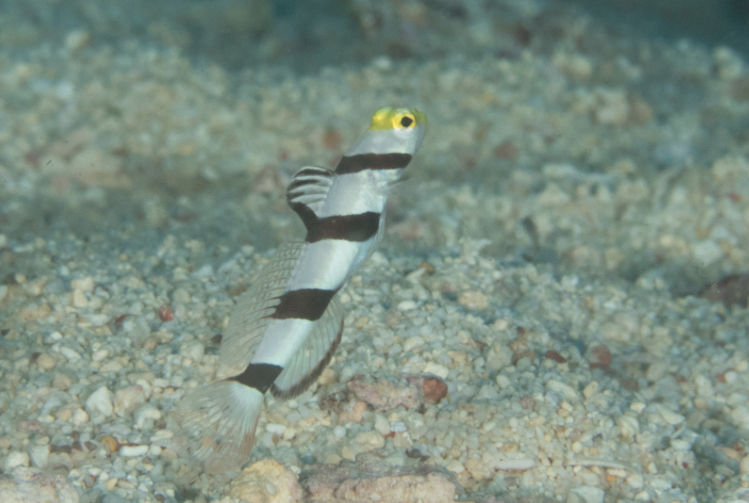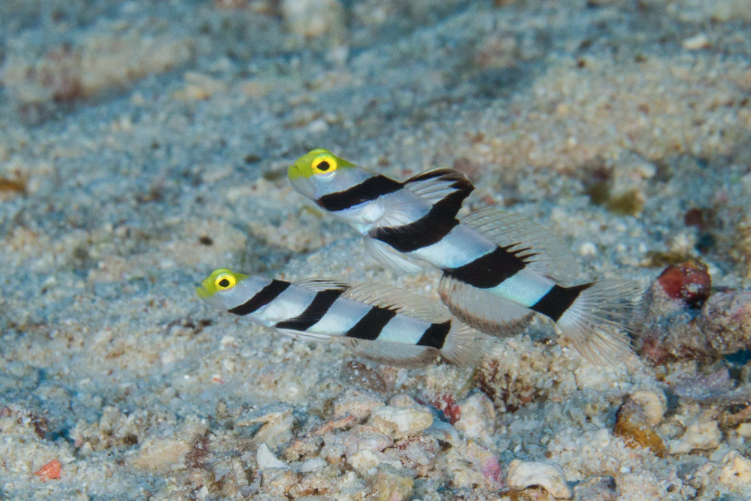The year is 1977. Star Wars is a box office sensation, Billy Joel is topping the charts with his multi-platinum album The Stranger, and the King of Rock & Roll, Elvis Presley, is found dead in his Graceland bathroom, but undoubtedly the year’s biggest story was the discovery of Stonogobiops dracula, a gorgeous red-striped shrimpgoby from the Indian Ocean that captured the imagination of aquarists worldwide.
This exciting new genus would soon quadruple in size with the addition of 3 more species in 1982—S. xanthorhinicus from New Guinea, S. nematodes from the Philippines, and S. medon from the Marquesas Islands—followed by Japan’s S. pentafasciatus in 1994 and the aquarium favorite S. yasha in 2001. And that’s largely where we’ve stood ever since… a brief flourish of nomenclatural exuberance followed by taxonomic silence. One might assume that we must know all that there is to know about this popular genus of pint-sized gobies, but there may yet be more secrets waiting to be revealed.
The relatively late discovery of this group can be attributed to a couple factors. Firstly, Stonogobiops are small, bottom-dwelling fishes that occur at moderate depths in sandy and silty environs, making them less likely to be collected with the trawls in use by early expeditions to the Indo-Pacific.
Secondly, and most importantly, their symbiosis with Alpheus pistol shrimps provides a convenient hole to dart into when threatened, essentially requiring that specimens be obtained with hand nets and tranquilizers, thus it was the widespread adoption of scuba diving that eventually allowed for the discovery of these fishes.
To date, little work has been done to improve our understanding of the group’s evolutionary history. It appears to be closely related to Myersina, a diverse genus of colorful and resplendently finned silt-dwelling shrimpgobies that is rarely seen in the aquarium trade; in fact, Western Australia’s S. larsonae was originally described in that genus and, judging by its unbanded color pattern, may rightfully belong there.
Within Stonogobiops, we can attempt to subdivide the genus into 3 recognizable lineages: one with a greatly elongated dorsal fin in both sexes (nematodes, yasha), another endemic to Japan with a short dorsal fin in both sexes, and black-tipped pelvic fins (pentafasciatus), and a third group comprising an allopatric mix of species whose females have a short dorsal fin (dracula, xanthorhinicus, medon); note that the male dorsal fin of the Pacific species does become elongated, but not as a slender filament—Jake Adams points out this morphological variation in a unique observation showing an interspecies trio, but incorrectly hypothesizes this male phenotype as a possible xanthorhinicus X nematodes hybrid.
It’s in this 3rd group where we find some unsolved mysteries. I’ve previously written about an unusual phenotype that has thus far only been documented from muck sites in the Lembeh Strait, near the northeastern tip of Sulawesi. This presumably undescribed species is easily recognized by its short, yellow-tinted dorsal fins and a black tip to its pelvic fins. It might also be expected to occur nearby in Tomini Bay, as this secluded region of the Coral Triangle hosts a few other endemic reef fishes with narrow distributions (e.g. Pictichromis dinar, Cirrhilabrus aurantidorsalis, Paracheilinus togeanensis, Chrysiptera giti).
Equally surprising is the presence of a distinctive population in Fiji that seems to have escaped notice until now and which at first glance appears nearly identical to the widespread West Pacific species S. xanthorhinicus. The only obvious difference is the presence of a thick grey band on the margin of the anal fin, present in mature specimens of both sexes; videos of this fish also show a greyish tint to the caudal fin of some large males. The consistency of this subtle trait, combined with its absence from populations elsewhere in the West Pacific, strongly indicates that this is an undescribed species.
This naturally raises the question of whether there might be any additional cryptic species lurking within this group, and that may well be the case. For example, specimens from Japan have a tendency to develop a black marking behind the eyes, whereas those from Indonesia and Melanesia often have a faintly reddened border to the yellow head, while those from Fiji lack this discoloration entirely, with the head evenly yellowed throughout. Additionally, the 3rd stripe of Japanese specimens is often developed anteriorly into a J-shaped marking, while in other populations it tends to remain well-separated as an obliquely vertical stripe.
For reasons that are unclear, specimens of xanthorhinicus from the Philippines are very poorly documented, and the group has many notable absences in the Central Pacific, being unknown from the Mariana Islands, most of Micronesia (save for Palau), and all of Polynesia, with the notable exception of the Marquesas Islands, where the closely related S. medon is regarded to be endemic. The enormous geographic gap separating Fiji’s S. aff xanthorhinicus and S. medon suggests that there may be an additional Stonogobiops waiting to be found; however, it’s surprising that the well-studied waters of the Cook Islands and French Polynesia have yet to reveal its presence.
Fijian fishes are commonly available in the aquarium trade, but I’ve yet to stumble upon any images showing this unique Stonogobiops in captivity. In fact, there’s surprisingly little fanfare for either of these xanthorhinicus phenotypes amongst aquarists, as these seem to be largely overshadowed in popularity by the likes of S. yasha and S. nematodes. A true rarity, Fiji’s undescribed shrimpgoby is likely out there somewhere swimming in a reef tank, hiding in plain sight.




